Table of Contents: Intro & 1920; 1921-1923; 1924-1927; 1928-1932; 1933-1935; 1936-1939; 1940-1945; 1946-1949; 1950-1953; 1954-1956; 1957-1959; 1960-1963; 1964-1966; 1967-1969; 1970-1973; 1974-1976; 1977-1979; 1980-1983; 1984-1986; 1987-1989; 1990-1993; 1994-1996; 1997-1999; 2000-2003; 2004-2006; 2007-2009; 2010; 2011; 2012; 2013; 2014; 2015; 2016; 2017; 2018; 2019; Recap & 2020
This week, the 100 Years of Buggy History series takes a look at the mid-1970s. We’ve got plenty of firsts in the 1974-1976 range. The first Sweepstakes Chairwoman! The first Rolls Reports! And of course, the our first introduction to the mythical being known only as Compubookie. We’ve also got organizations running under new names (SDC, ZBT), C Teams, and all kinds of controversy.
1974
Raceday: Prelims on Friday, April 19 at 9:00am; Finals on Saturday, April 20 at 9:00am
Sweepstakes Committee: Dary Turner (Chair); Tom Wood (Safety); George Wargo (Design); David Kanner (Publicity/Buggy Book)
Race Results: (1) SigNu A – Hornet (2:20.2 – COURSE RECORD); (2) PhiKap A – Streak (2:22.0); (3) Beta A – SST (2:22.8)
Design Comp: (1) PhiKap – Streak; (2) Fringe – Flying Buttress; (3) PhiKap – Snorpus
Weather: Partly Cloudy, 47-53 Degrees on Friday; Sunny, 51-59 Degrees on Saturday
Buggy Book: 1974 Buggy Book Link
Prediction Score (Overall Consensus): 16/40
1974 saw the merger of the Men’s and Women’s Dorms, the emergence of SigNu, and introduced the world to an unknown creature known as Compubookie.
- Merger of the Dorms. On March 3, 1974, a general membership meeting of the Women’s Dormitory Council voted to merge with the Men’s Dormitory Council to create one overall group. The new organization would be called the Student Dormitory Council (SDC). But the merger seems to have put a lot of things in flux, including Buggy. SDC had a slot on Raceday, as they were scheduled to roll in Heat 1 out of Lane 2, but they ended up not racing in 1974.
- Buggy Cost Update. We like to check in on the costs of Sweepstakes whenever we get the opportunity, and thanks to the February 12, 1974 Tartan, we have some information about 1974. The budget for Carnival 1974 (including Midway and Buggy) was $4,000, which was provided by Student Senate and covered the parade permits needed to close the roads, plus a $25/buggy entry fee for the race.
- Limited Rolls. 1974 was a rough year for practice rolls. As a reminder, in the early 1970s, practice rolls took place on the 6 Sunday mornings leading up to Spring Carnival, far fewer than the number of practice rolls in place today. In 1974, 2 of those 6 were rained out. A third day was delayed because security did not arrive on time, and it ended early after an accident during practice. An unidentified buggy, which we believe belonged to DTD, ran into a concrete abutment in the Chute, and the driver was taken to the hospital, where he received 2 stitches in his forehead. Thankfully, this happened several weeks before Raceday and the buggy was not traveling at raceday speeds, so the driver avoided serious injury. But CMU wasn’t happy, and reportedly the administration threatened to end buggy forever, on the grounds that it was unsafe. The overhaul of the safety rules helped alleviate the administration’s concerns. As a result of the lost rolls, Sweepstakes got an additional permit for rolls on Saturday, April 6…but ironically, it was also rained out.
- The First Rolls Report. Readers may be used to seeing a weekly rolls report posted on the BAA website, but rolls reports weren’t always a thing. However, the April 16, 1974 Tartan gives a report of Rolls from Sunday, April 7. In total, 18 “heats” were run during the 2 hour practice. SAE’s new buggy, Intrepid, added wheel covers for the first time, and put up some impressive times. ATO spun out in the Chute while trying to avoid the haybales, which the Tartan suggests was not an uncommon occurrence for ATO. The best time of the day belonged to PhiKap’s Streak with a 2:35, while PiKA’s Pi-thon was close behind with a 2:38. The report notes that DTD was actually able to stay on the course and out of the ER this time (which is why we suspected that the earlier crash that cancelled rolls was a DTD buggy). Meanwhile, SigNu, who had failed a brakes test earlier in the week, decided to prove that brakes were, in fact, in their buggy this time by ejecting them in the middle of a roll.
- More Paved Roads. Getting Frew Street paved was the top priority prior to its paving in 1972. But while Tech Street wasn’t as bad, it could also use a new coat of asphalt. In 1974, that came to pass, as CMU got the City of Pittsburgh to pave Tech Street prior to Raceday. The fresh roadbeds increased the likelihood of a course record being set.
- New Buggies. A couple of new buggies made their way to the course in 1974. The best of the lot belonged to Beta, who rolled out their new monocoque fiberglass buggy, SST. DTD finished a new buggy, which was officially named Delta Queen, though we don’t have a report of whether that buggy was actually used on Raceday 1974. CIA finished a build in 1973 but didn’t get it out to the course, so their new buggy made its debut in 1974. That buggy was originally named The Peanut, but it’s better known for the name it ultimately assumed, Streetcar Named Desire. KapSig, meanwhile, began working on a buggy, but didn’t finish it by Raceday, so it would need to wait until 1975 to debut. SigNu also put together a new buggy, Sinex, to roll as their B team buggy. And SAE made major changes in 1974. First, they rebuilt their bike after the wheel failure and bad crash in 1973, and dubbed the new bike “Arnold II”. Then, they used what they learned in 1973 when building Intrepid to rebuild a 4-wheeled buggy, which was codenamed “The Phoenix” but eventually earned the clever name Intrepid II. Intrepid II featured a new body design (after the original body was damaged during late night testing) with a thin flexible sheet around the center to allow for easier loading and unloading of the buggy, and in a departure from the norm of the early 1970s, the buggy featured no suspension at all. The new version of Intrepid also swapped out a single pivot 4-wheel steering system for fixed axles bolted to the aluminum chassis, with a simple knuckle/tie rod steering on the front wheels, though it retained the original Intrepid’s braking system. Intrepid II weighed approximately 65-70 pounds, without a driver.
- Introducing…Compubookie. The 1974 Tartan ran multiple different predictions, including from the Sweepstakes Chair, the Safety Chair, the Design Chair, the Publicity Chair, and a “Non-Contenders’ Poll”. But the biggest name of all from the predictions was in the byline – Compubookie. Yes, Compubookie made its official debut in 1974, though it was a little different in its first incarnation. Rather than a full org-by-org breakdown, Top 10 prediction, and a bunch of one-liners, Compubookie discussed the 4 organizations that it thought had a chance, in no particular order. They were: PhiKap (destined to finish in the Top 3, thanks to a superior push team, best driver, and a buggy that rolls as well as it looks); Beta (rumors of a new buggy don’t matter, because either way they’ve got one of the best buggies on the course); ATO (if their new buggy can make it through the Chute, they’ve got the pushers to compete); and PiKA (a falling former great buggy empire with no returning drivers and an A push team that is “the largest collection of prima donnas this side of the U.S. Senate”).
- SigNu Finally Breaks Through… SigNu wasn’t expected to put up a top time. Their buggies, which had brakes issues in the past, consistently put up times that moved them onto the Finals, but only occasionally were they a top 3 team, and more often than not they seemed to encounter some sort of mechanical issue or other bad luck. But in 1974, they finally put it all together. In the Prelims, SigNu A’s Hornet had a 50 second freeroll (at a time when 60 seconds was considered average). It also helped that the buggy was light enough for pushers to use the bump-and-run technique, typically only seen with the bikes. This helped SigNu A put up a Prelim time of 2:21.4, the second fastest roll of all time. But they topped it in the finals, setting a course record with a 2:20.2 time. The reaction of their Hill 5 pusher as he crossed the finish line tells you everything you need to know about how unexpected the victory was.
- …But with a Catch. But it wasn’t all sunshine and rainbows for SigNu A, as there was a moment when it looked like their bad luck might strike again. SigNu A was assigned to Prelims Heat 5, where they went up against SAE B (in Lane 1) and Fringe A (in Lane 2). Immediately after the race, which SigNu won, a member of DTD lodged a formal protest against SigNu A. The member of DTD alleged that SigNu had a pacer on Hill 5. The Sweepstakes Committee and judges took 45 minutes to review the complaint. Ultimately, they determined that the “pacer”, a SigNu flagger, had been running behind the SigNu Hill 5 pusher and that the pusher was unable to see the flagger. Therefore, the “pacer” had no effect on the pusher, and Sweepstakes elected not to DQ SigNu.
- Rounding out the Top 6. Beyond the surprise of SigNu’s victory, the rest of the Championship Heat wasn’t unexpected. Beta’s new buggy, SST, rolled very well for their A Team and put up a time of 2:22.9 on Friday, while PhiKap’s Streak ran a 2:23.7, earning the other two spots in the Championship Heat. On the consolation side, it was an ATO affair, as their A team buggy, Gander, put up a time of 2:25.7 and their B team buggy, Golden Goose, did a 2:30.0, good for 4th and 6th respectively and earning both teams a spot in the Consolation Heat. The remaining Consolation Heat spot went to PiKA A’s Pi-thon, with a 2:27.0. Of course, all 3 Consolation Heat buggies went slower on Saturday, with ATO A winning with a 2:28.5, PiKA A close behind with a 2:29.4, and ATO B a little further back in 2:31.8.
- Alumni Heats. Officially, only 1 Exhibition Heat was on the schedule, and it was scheduled to be a battle between the alumni of PhiKap, ATO, and PiKA. But in a sign of things to come, alumni times were actually recorded, and 4 teams ended up competing (our assumption is that the Exhibitions were run as 2 heats of 2). The winning Alumni team belonged to PhiKap, who put up a time of 2:48.3. Second place went to a group identified in the 1975 Buggy Book as “Day Care”, but my assumption is that this is the ATO alumni team, who ran the course in 2:54.7. Rounding out the other two spots were SigNu and PiKA, who finished the course in 2:55.8 and 3:03.6, respectively.
- Full Results. The full results for 1974 are available in the 1975 Buggy Book, but until we get our database updated, we are repeating the times here:
- SigNu A (Hornet) – 2:20.2 (Prelim Time: 2:21.4)
- PhiKap A (Streak) – 2:22.0 (Prelim Time: 2:23.7)
- Beta A (SST) – 2:22.8 (Prelim Time: 2:23.9)
- ATO A (Gander) – 2:28.5 (Prelim Time: 2:25.7)
- PiKA A (Pi-thon) – 2:29.4 (Prelim Time: 2:27.0)
- ATO B (Golden Goose) – 2:31.8 (Prelim Time: 2:30.0)
- Fringe A (Flying Buttress) – 2:32.6
- PhiKap B (Snorpus) – 2:33.6
- SAE A (Intrepid II) – 2:36.2
- PiKA B (T-2) – 2:37.2
- Beta B (825) – 2:37.7
- DTD B (Unknown Buggy) – 2:40.7
- CIA A (The Peanut/Streetcar Named Desire) – 2:41.8
- DTD A (Unknown Buggy) – 2:44.4
- KapSig A (I Forget (nee Pipe Dream III)) – 2:45.4
- SigNu B (Sinex) – 2:45.5
- CCCP (Unknown Buggy) – 3:32.8
- DU A (Captain America) – 4:09.4
- DNF/DQ: SAE B (Arnold), Tau Delta Phi A (MF 69 P.W. No. 13 Le “D”)
- 1974 Photos. Below are some additional photos from 1974:





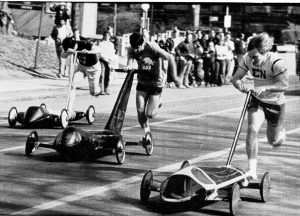




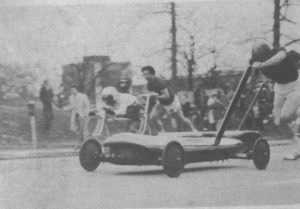
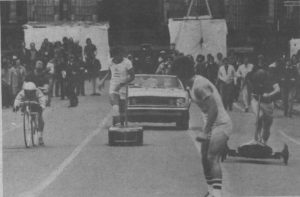
1975
Raceday: Prelims on Friday, April 18 at 9:00am; Finals on Saturday, April 19 at 9:00am
Sweepstakes Committee: Dave Kanner (Chair); Bob Davis (Safety); Greg Homoki (Design); Roger Geddes (Publicity); Mick Pro (Buggy Book)
Race Results: (1) PiKA A – T-2 (2:19.3 – COURSE RECORD); (2) SigNu A – Hornet (2:23.2); (3) Beta A – SST (2:25.7); (4) Beta B – 825 (2.29.7); (5) ATO B – Mongoose (2:30.7); (6) SAE B – Intrepid II (2:32.8)
Design Comp: (1) PhiKap – Shadow; (2) SAE – Intrepid II; (3) Fringe – Flying Buttress
Weather: Cloudy, 64-65 Degrees on Friday; Rain early, 54-58 Degrees on Saturday
Buggy Book: 1975 Buggy Book Link
Prediction Score: 19/40 (Compubookie); Best Score: Greg Homoki (Design Chair) – 21/40
In 1975, the Buggy field expanded in more ways than one, with Theta Xi returning to the course and Sweepstakes allowing C teams for the first time. But it wasn’t all positive, as plenty of Raceday incidents and some questionable decisions by Sweepstakes led the year to be known as “the year of the tainted Sweepstakes.”
- The Importance of Buggy. Sometimes, we just like to see what people in the general community were saying and reading about Buggy. An article written by Sweepstakes Chair Dave Kanner in the January 21, 1975 Tartan aimed to show why the CMU community, and more importantly the Administration, should support Buggy in an article entitled “The Importance of Buggy.” The summary of the article is that there are 4 main reasons to support Buggy: (1) Tradition (it’s a 55-year old sport); (2) Alumni Participation (“nothing brings more alumni back to this school than buggy”); (3) Spirit and Pride (“there is not a whole lot to be proud about at CMU, but anyone who had anything to do with his team’s buggy effort certainly has something to be proud about); and (4) Good, clean fun. The point of the article was to explain, to those who don’t know, that “buggy is a unique and exciting experience which is as vital to this school as any other facet of life here at CMU.” 45 years later, I think we can all agree with this sentiment.
- Another Rough Weather Year. We don’t have Rolls Reports from 1975, but we do know that Rolls didn’t go off without a hitch. The 1975 Thistle notes that many of the Spring Rolls were cancelled due to late snowfalls and wet roads.
- Adding a 3rd Team. In 1975, Sweepstakes decided to expand the potential field of buggies. Instead of allowing a maximum of two teams per organization, Sweepstakes raised the maximum to 3 teams, thereby allowing organizations to enter a C team for the first time. Two organizations took advantage of the addition; PiKA and Beta. In total, 24 teams entered, and the full heat schedule is available in the Buggy Book.
- Theta Xi Returns. Theta Xi had taken a few years off from Buggy, having last raced in 1971. But they returned in 1975 with their unique feet-first buggy, Xiclone. Of course, the inexperience of the team limited expectations for the fraternity.
- What’s In A Name? Tau Delta Phi lasted at CMU for a while, starting some time around 1930 and withstanding World War II, when other fraternities could not start up again. But 1974 appears to have been the end of the 45 year old fraternity…kinda. The CMU chapter of TDP didn’t disband as a fraternity, they just changed their national affiliation, becoming the CMU chapter of Zeta Beta Tau (ZBT). But that wasn’t the only name change for the fraternity when it comes to Buggy. In 1969, they debuted their bike, No. 13, and No. 13 came back in 1970. But every year after that, TDP “updated” the name of their A team buggy. In 1971, the buggy became D-13. In 1972, it became No. 13 Le “D”. In 1973, it was changed to P.W. No. 13 Le “D”. In 1974, it reached its peak, with the name MF 69 P.W. No. 13 Le “D”. So it’s unsurprising that ZBT again changed the name in 1975, referring to the buggy as Mountain Oyster No. 13.
- What’s In A Name Pt. 2. In 1974, DTD had a stable of 3 buggies. In 1975, they chose 2 of those buggies to compete with, but the then-current brothers must not have been happy with some of the decisions that the previous brothers had made (or they were just really big fans of the TV show M*A*S*H). Instead, they decided to make these buggies their own, and renamed them. The two buggies that DTD rolled in 1975 were renamed “4*0*7*7” (Delta Queen, we believe) and “Hotstuff” (Green Grunge, we believe). But the name change was temporary, as the buggies went back to their usual names, Delta Queen and Green Grunge, in 1976.
- New Buggies of 1975. A couple of organizations brought out new buggies in 1975. Leading the way was PhiKap, who introduced their new buggy, Shadow. Shadow had a monocoque, fiberglass body, hydraulic disc brakes, four-wheel independent suspension, and a high-strength pushbar. ATO finally retired their champion, Golden Goose, and replaced it with the similarly named Mongoose. KapSig, meanwhile, finally brought out the buggy that they had been building for the previous 2 years (though it only made one appearance at rolls before Raceday), named Red Baron. SAE once again remodeled their 4-wheeler, Intrepid II, by drilling holes in the aluminum body to lighten the buggy. And PiKA didn’t build a new buggy, but because of the expansion to 3 teams, they brought back their original Tiger Shark I, which hadn’t seen a Raceday since 1967.
- Compubookie Predictions. Compubookie added a little extra starting in 1975, sneaking in words related to the teams being discussed as part of the writeup (for example, for ATO, Compubookie writes “The Golden Goose laid an egg called the Gander but neither of these birds are a match for a Buzzard. Before you get all Pyzed off about that pun, somebody better give them a brake.”) This is a style that Compubookie would continue to use for a number of years. I’m typically not going to repeat Compubookie’s full writeup here, but I will make the page available as an image, In case people want to read what Compubookie had to say. Instead, I’ll just give the actual predictions, which this year was: (1) PiKA A; (2) Beta A; (3) ATO A; (4) SigNu A; (5) PhiKap A; (6) Fringe A. In addition, the Tartan included predictions from Dave Kanner (Sweepstakes Chair), Bob Davis (Safety Chair), Greg Homoki (Design Chair), Mick Pro (Buggy Book Editor), Roger Geddes (Publicity Chair), and a collective prediction from the Buggy Chairs.
- Incidents Galore. It wasn’t a smooth Raceday for Sweepstakes 1975. The trouble started in Prelims Heat 1. SAE rolled their Bike as their A team buggy, but one of the wheels fell off shortly after the race began. Things got worse in Prelims Heat 2. ATO B and Fringe A reached the Chute together, and ATO B’s buggy,
GanderMongoose, crashed into Fringe A, forcing Fringe’s buggy, Flying Buttress, into the outer curb and badly damaging the buggy. Fringe’s driver, Toby Kramer, suffered a laceration when an abrasion on his chin reopened as a result of the crash.ATO B was DQ’d for the interference, andFringe A was granted a reroll [Ed. Note: After further review, we don’t believe that ATO B was actually DQ’d. Rather, this appears to be the team that finished 5th, not ATO A]. A further mishap came in Prelims Heat 7, when a vehicle broke through the barricades and impeded both Beta A’s SST and CIA A’s Streetcar Named Desire in their rolls. And then, in Prelims Heat 8, PhiKap A’s Shadow (out of Lane 3) crashed into PiKA B’s Pi-thon (out of Lane 1) in the Freeroll. PhiKap A was DQ’d for initiating the contact with PiKA B, though they were still declared eligible for Design Competition, and PiKA B was granted a reroll. And Fringe and PiKA weren’t the only ones; in total, 5 teams, including Beta A and CIA A, were granted rerolls, all of which were scheduled to be held on Saturday…
- Sweepstakes Makes a Quick Call. Unfortunately for the 5 teams who were granted a reroll during Saturday’s rolls, Saturday’s rolls never came. Rain fell early Saturday morning, and Sweepstakes made the decision to cancel Day 2, leaving the results of the Prelims to stand as final times. Not everyone agreed with this decision, however. The Tartan’s photo recap of Carnival included the headline “it almost didn’t rain at all”, and another caption heading reads “Chairman Irate.” The Tartan cites “many of those involved” in Buggy saying that the races could have been run, given enough time for the course to dry, and that the cancellation decision was made too quickly.
- And More Drama. But the quick cancellation wasn’t the only issue that arose for Sweepstakes in 1975. CIA and SDC both lodged a formal protest that SigNu should have been ineligible to race on Raceday, because SigNu failed to bring their buggy to Rolls. Other teams reportedly protested their times on Raceday, arguing that they were incorrect. According to a column titled “Buggy Comments” in the February 17, 1976 Tartan, a lot of these issues were the result of vague and ambiguous rules related to fouls and the qualifications for rerolls, making it tough for the judges to determine whether something was a foul and whether a reroll should be granted. The complaints left a bad taste in Sweepstakes Chair Dave Kanner’s mouth, as he stated after the Awards Ceremony that “I really hope they can find someone to be Sweepstakes Chairman next year, because when they find out what I went through this year, no one will ever take the job.” As a note, Sweepstakes did not find a chairman for 1976, but more on that below.
- Tainted Love. Acknowledging that Raceday 1975 was flawed, Sweepstakes Chair Dave Kanner made a speech during the Awards Ceremony. The April 22, 1975 reprinted the speech in full, and so I thought I’d do the same. “There are a number of things that can go wrong with a buggy race, and I guess that this year everything that could have gone wrong did. I realize that the circumstances surrounding the ’75 Sweepstakes generated a lot of hard feelings among a large number of people. If any of these feelings are directed towards Bob [Davis, Safety Chair] or myself, I apologize and I hope that we can all forget these feelings by tomorrow morning. If anyone saddles the blame for this year’s screw ups on Bob or myself, I ask you to reconsider. We did the best job we could, and considering some of the crap we had to put up with, it was a superhuman effort. It is indeed unfortunate that 1975 will be remembered as the year of the tainted Sweepstakes. The people who are about to receive these trophies worked hard for them and they truly deserve them. Hopefully, we will someday be able to look back at this and laugh at ourselves.” [Editor’s Note: Looking back at this, 45 years later (and not having been present that day), I did, indeed, laugh a bit and enjoy what ultimately turns into a pretty good story, even if it probably didn’t feel great in the moment.]
- 1975 Photos. Below are some photos from 1975:


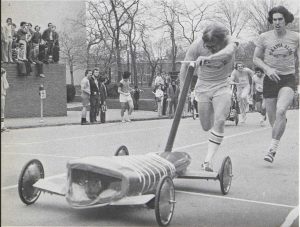
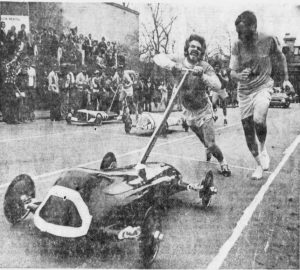
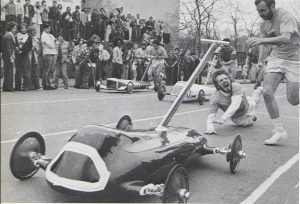
1976
Raceday: Prelims on Friday, April 9 at 7:00am; Finals on Saturday, April 10 at 7:00am
Sweepstakes Committee: Joan Bothwell (Chair), Charles Campbell (Safety – Fall); Jim Belawski (Safety – Spring), Bill Fox (Design), Sue Murtha (Publicity), Chip Yeager (Buggy Book)
Race Results: (1) PiKA A – T-2 (2:23.3); (2) Beta A – 825 (2:24.6); (3) ATO A – Gander (2:25.0); (4) PhiKap A – Streak (2.26.5); (5) SigNu A – Hornet (2:26.7); (6) Fringe A – Flying Buttress (2:28.6)
Design Comp: (1) SAE – Intrepid II; (2) CIA – Black Magic; (3) PhiKap – Streak
Weather: Sunny, 29-36 Degrees on Friday; Sunny, 29-42 Degrees on Saturday
Buggy Book: 1976 Buggy Book Link
Prediction Score: 27/40 (Compubookie); Best Score: 29/40 (Buggy Chairmen)
1976 us more information than any year we previously had, thanks to a weekly Rolls Report and a detailed, heat-by-heat recap printed in the Tartan. But it wasn’t just a big year for information. It was also a big year for Sweepstakes, as they elected their first ever Chairwoman, battled Student Senate and Phipps Conservatory, and performed a comprehensive review of the rules.
- Sweepstakes Chairwoman. 1975 Sweepstakes Chair Dave Kanner was prescient when he warned that no one would want to be Sweepstakes Chairman in 1976 after seeing what he went through the previous year. It turns out, he was right – only 1 man volunteered for the job, but he graduated in 1975 and was no longer eligible. Luckily, there was a whole separate applicant pool at CMU that had never been tapped for the Chair position before. That changed when Joan Bothwell, a sophomore design major who was unaffiliated with any Buggy team, volunteered for the job. An article in the October 7, 1975 Tartan noted that she may not have been the most qualified person for the position, but she had the one quality that others didn’t – her willingness to try. She was approved by Student Senate and was officially made Sweepstakes Chair for the 1975-1976 year. And by the end of the year, the Tartan called her “one of the best Sweepstakes Chairpeople that buggy racing has seen for quite a few years.”
- Safety Chair Elections. Charles Campbell played the role of Safety Chair for the Fall, but he did not return to CMU for the Spring, so Sweepstakes was forced to hold a new election. Elections are held every year, but rarely do we have a record of the election. Luckily, in 1976 the Safety Chair election was covered in the “Buggy Comments” column in the 1976 Tartan. A somewhat surprisingly large slate of 3 candidates ran for the position: Jim Belawski (Beta), a senior chemistry major, Lou Conley (CIA), a graduate MechE, and Jim Plymyer (PiKA), a junior EE. The vote was straightforward and uncontroversial, and Jim Belawski won on the first ballot.
- Rules Refresh. The 1976 Sweepstakes Committee began the task of refreshing the rules. This had not been done since the safety rules were enacted, but some believed that the update was sorely needed. Now that the safety rules had been in effect for a few years, one area that Sweepstakes looked at was refining some of those rules to make them more effective and better reflect Buggy practice. Other areas included the clarification of rules around fouls and rerolls, and the use of alumni as judges (rather than university administrators and officials, who may not have as much familiarity with Buggy).
- Changes to Finals and Rerolls. One change that was officially made dealt with rerolls and podium placings. In 1976, Sweepstakes officially abandoned the idea of a Championship Heat determining the Top 3 teams and a Consolation Heat determining 4th-6th. Instead, the final placings would be determined based solely on time; so instead of a “Championship Heat” and a “Consolation Heat”, there was “Finals Heat 1” and “Finals Heat 2”. Finals Heat 1 consisted of the 2nd, 4th, and 6th fastest Prelim times, and Finals Heat 2 was the 1st, 3rd, and 5th fastest times. If a buggy in Finals Heat 1 rolled faster than a buggy in Finals Heat 2, the faster buggy would earn the better placing. In addition, for the first time, the rules required rerolls to be run on Saturday, and the reroll time would count as the Buggy’s final time (so that no team would need to push twice in one day). However, unlike years past, the reroll would not affect the Top 6 times from the previous day for purposes of Finals Heats. So the top 6 times from Friday would qualify for the Finals Heats, regardless of any rerolls. The reroll times would only affect podium placings (so if a reroll time was faster than one of the Finals Heat times, the buggy that rerolled would earn the placing).
- Traffic Control and Radio Club. One of the top priorities for the new Sweepstakes Committee in 1975-76 was to improve traffic control during practices to avoid some of the problems of years past. The plan was to use walkie-talkies to radio when buggies were rolling, so that the barricaders would know when to make sure the roads stayed closed, and when they could let traffic through. But that plan would have required spending money upfront that Sweepstakes didn’t have (see below). So until walkie-talkies could be obtained, before every roll a designated car would drive completely around the course, telling all of the barricaders to close the course to all traffic. After the last buggy had sufficient time to complete the course, the same car would drive around again and let the barricaders know that they could let the cars pass. As the semester went on, Sweepstakes looked to other organizations who could provide the walkie-talkies. Initially, ROTC offered walkie-talkies, but they would not be available until Spring. So instead, Sweepstakes reached out to W3VC (Radio Club), who agreed to provide 2-way radios and the manpower for it. And 45 years later, Radio Club still provides this service.
- Fight over Buggy Funding. The biggest battle of the year in Buggy didn’t come from PiKA and SigNu, or PhiKap and Beta. No, the biggest battle of the year in Buggy was between the Sweepstakes Committee and the Student Senate. The fight was over the 1975-76 Sweepstakes budget. The Finance Committee demanded major changes to the Sweepstakes budget that had initially been submitted before it could be approved. Those changes included reducing money allocated for trophies from $250 to $200, reducing the money requested to cover practices by 20%, tabling a $230 allocation for capital improvements (i.e., four walkie-talkies and a bullhorn to help alleviate traffic control issues), and increasing the portion of funds provided by Sweepstakes itself by raising the entry fee. The capital improvement amount was tabled to see if another organization already had this equipment that Sweepstakes could use, and the trophy reduction only limited what Sweepstakes could do for the 9 trophies awarded. The biggest issue, however, was the reduction in money for practice rolls. The Finance Committee required Sweepstakes to reduce the number of practice rolls, as it reasoned that there weren’t many new drivers this year, and veteran drivers did not need as much practice. The maximum number of practices was set to 9 (which, according to the Finance Committee, was more practice sessions than any previous year). As for the self-financing of Buggy, Sweepstakes had 3 sources of funding: Student Government, Entry Fees, and Buggy Book income. The Finance Committee determined that 50% of funding for Sweepstakes coming from Student Government was too high, and that Sweepstakes should raise the entry fee from $25 to $35 for the first buggy (subsequent buggies would remain $15 each), which would reduce the share of the budget coming from Student Government from 50% to 41%. The back-and-forth in the Tartan, battled out in the editorial and Letter to the Editor sections, gets into an interesting debate over the Student Senate Constitution and Bylaws, the power of Student Senate to dictate an organization’s finances, and the power dynamics of student-led governments, but most of that isn’t relevant specifically to Buggy, so I’m leaving all that back-and-forth out of this post.
- Paving is Complete. In 1972, the City of Pittsburgh finally got around to paving Frew Street. In 1974, they moved on to Tech Street. So it was only fitting that in 1976, the freeroll portion of the course was paved. This put the course in about as good condition as one could ask for on Raceday.
- Phipps Interrupts Buggy. Buggy and the Phipps Conservatory haven’t always had the most symbiotic relationship. But rarely has the conflict over Schenley Drive played a bigger roll in Buggy that in 1976. That year, Phipps Conservatory held the Pittsburgh Flower Show on the same days as Spring Carnival (April 9-10), and the Flower Show began as early as 9am. This prevented Sweepstakes from being able to close the roads at the normal Raceday time. Therefore, in order to hold the races, Raceday 1976 was moved earlier in the morning. Both Prelims and Finals were scheduled to start at 7am, and were required to be completed by 9am in order to get the roads opened by 9:30am, so that people could park at Phipps for the flower show.
- A Former Competitor Reemerges. A “new” fraternity took to the course in 1976. Beta Sigma Rho had stopped competing in Buggy in 1972, and the national fraternity ended up disappearing. Instead, BSR merged into Pi Lambda Phi (PiLam), and the CMU Chapter officially made the switch in 1974. But it still took a couple more years for the organization to re-enter the competition, and they were a late entry into 1976 Raceday. We don’t know much about their first buggy (it’s possible that they used the buggy Duck, which was BSR’s last active buggy), other than that they did not put up a top caliber time.
- New Buggies. A few new buggies hit the course in 1976. CIA took what they had learned from building Streetcar Named Desire and made some improvements, resulting in their new buggy, Black Magic. DU retired their 2/4-wheel hybrid, Captain America (as mentioned below), and instead build a front loader with a solid shell named Phoenix. PiKA built a new version of their classic buggy Shark, known as Shark II (S-2). As noted above, PiLam was a new addition to buggy, and so they brought with them a new build, called “Untitled No. 1”. SDC also built a new buggy after using a loaner for practice in 1975 (as discussed briefly below), referred to as both Hawk and Shadowfax. SDC also brought out a bike for 1976, though it’s unclear where that buggy came from or if it had a name.
- Rolls Reports. For the first time, we have real Rolls Reports! A Tartan sportswriter going by the byline “L.S.D.C”, who was clearly involved with Buggy, published a (mostly) weekly column in Tartan titled “Buggy Comments” during the Fall semester, beginning with the first Sunday rolls on October 14. These write-ups were essentially Rolls Reports in weeks when there were practice rolls. This is also the first time that we have record of a Fall practice roll period. Below is a summary of the Rolls Reports for 1975-1976.
- October 12 (Rolls #1) – Only 5 orgs were out at Rolls, but that made it easy for the orgs that were out to get a number of rolls in. The orgs had a mix of new drivers learning how to drive and veterans getting in some practice. Sweepstakes Chair Joan Bothwell was out of town, so Rolls were run by CIA’s Co-Chairman Ruth Wels, and Fall Safety Chair Charles Campbell was on hand to inspect buggies and administer Drops. Meanwhile, after rolls ended, 15 haybales went missing.
- October 26 (Rolls #3) – No Rolls Report was printed for Practice #2, on October 19. Practice #3, meanwhile, did get a slight write-up. Why slight? Because the rolls were cancelled due to wet roads! But they weren’t wet for the reason you might think. A light rain fell on Saturday night, but the course had mostly dried out and rolls would have been possible. However, on Sunday morning, just before sunrise, the City of Pittsburgh sent one of their street cleaning trucks to the Chute to clean off some debris (possibly, though not confirmed, at the request of someone connected to Buggy). This sounds good in theory, and the truck did a good job in cleaning the Chute…but it turns out that not only do street cleaners sweep the street, they also wet the street in order to clean it. Between the time and the cold weather, there wasn’t enough time for the Chute to dry, so shortly after 7am, the Sweepstakes Chair cancelled rolls.
- November 16 (Rolls #4) – The weather was perfect for Rolls, though it was cold. 7 of the 14 orgs were in attendance, but the Rolls Report claimed that only PiKA and PhiKap actually seem interested (this comment received heavy criticism in Letters to the Editor). The big story from the Rolls came from SDC. The buggy used for practice by SDC in 1975 (they did not end up racing) was a loaner, so in order to get some experience for Raceday 1976 and give practice to their 4 potential drivers (1 veteran, 3 new), they built a buggy for the Fall. According to 1977 SDC Buggy Chair Frank Worbs, the buggy, Shadowfax, had an aluminum welded tube frame with flat parallel strips of titanium as the axles, with a flat plastic sheet bent over as the top of the body (aluminum on the bottom). But per some letters to the editor in the Tartan, thanks to the general loosening of some nuts and bolts from work being done the night before, the buggy encountered steering issues on the course. In its first roll, veteran driver Dan Capouellez did everything he could to avoid hitting a curb. When he got back to the tent, he recommended that SDC scratch for the rest of the day due to his lack of control. But instead of scratching, SDC tightened the nuts and bolts and went back out. On the second roll, new driver Kathy Schollaert encountered the same issues, but this time was unable to keep the buggy away from the curb. She hit the curb on the right hand side of the street just over the top of Hill 2. According to her now-husband (and former SDC Buggy Chair) Frank Worbs, Kathy was taken to the hospital while still in the buggy as a precaution, which apparently terrified some at the hospital, who thought it was a part of a car that had collapsed around her. Ultimately, her injury was minor; just a scratch on her right hand. But it was the last time Kathy drove a buggy for SDC (and who can blame her). In addition to the SDC drama, PhiKap also had a spin in the Chute, losing “some of its tires” and spewing rubber in all directions. The driver was uninjured.
- November 23 (Rolls #5) – The last Rolls of the Fall semester ended up being cancelled. 6 organizations decided to brave the 27 degree weather; unfortunately, Pittsburgh Police were not as brave. Sergeant Hickey and his team of officers failed to show to close the roads. Sweepstakes waited for an hour, even trying to contact him by phone, but they were unable to reach him and at 7:20am, the Sweepstakes Chair did what she had to do in cancelling rolls.
- Spring Rolls – The Spring Semester did not include a Rolls Report for most days. But we did get one last recap after the final practice of the year, the week before Raceday, which gave us some insight into the rest of the semester. The weather cooperated in 1976; only 1 freeroll practice had to be cancelled due to rain, and Sweepstakes added an extra Saturday practice on April 3 to make up for it. The last 2 practices saw accidents from CIA, Beta, and SAE, but no serious injuries. The worst of the accidents came from DU’s Captain America, whose driver was sent to the hospital and received 6 stitches after a crash, prompting DU to retire their patriotic buggy. All of the traditional Buggy powers had been rolling well throughout the Spring, but leading the pack was PiKA with their impressive freeroll times and solid push team. After PiKA, opinions differed as to who had been the best. One darkhorse candidate according to L.S.D.C. was CIA, whose new buggy, Black Magic, was freerolling “exceptionally well”, but didn’t quite have the top tier of pushers.
- Design Comp Changes. Another change made in 1976 involved the judging of the Design Competition. The new rules involved 6 judges awarding up to 150 points each to each buggy. The highest and lowest scores were then eliminated. From there, the remaining 4 scores were summed up, and the buggies with the 6 highest scores advanced to a final judging round. In the final round, the judges all reexamine the 6 remaining buggies, at the same time, during a twenty minute period. At the end of the examination period, each judge was asked to rank the buggies from 1 to 6. The ranks of each buggy were then summed up, and the lowest total was declared the winner. If 2 buggies tied in ranking, the buggy with the highest point total from the preliminary judging would win the tiebreaker. The final results were: (1) SAE – Intrepid II; (2) CIA – Black Magic; (3) PhiKap – Streak; (4) PhiKap – Snorpus; (5) Beta – SST; and (6) Beta – 825. For those interested, the full point totals after the preliminary round were:
- PhiKap – Snorpus (490)
- PhiKap – Streak (482)
- SAE – Intrepid II (470)
- Beta – 825 (469)
- CIA – Black Magic (450)
- Beta – SST (448)
- Fringe – Flying Buttress (433)
- SigNu – Hornet (422)
- KapSig – Red Baron (406)
- DTD – Delta Queen (401)
- ZBT – Mountain Oyster MF No. 13 Le “D” (390)
- PiLam – Untitled No. 1 (369)
- Theta Xi – Xiclone (363)
- SDC – Hawk/Shadowfax (345)
- DU – Phoenix (335)
- PiKA – Shark II (324)
- ATO – Gander (290)
- Predictions. In addition to Compubookie, the Tartan received predictions from the Sweepstakes Chair, Safety Chair, Publicity Chair, Design Chair, Buggy Book Chair, and Org Buggy Chairmen. PiKA and PhiKap were seen as the top 2 in the predictions, and the most accurate of the predictions went to the Org Buggy Chairmen (who nailed the top 5 teams, flipping 3rd and 4th and otherwise getting it right). No one predicted Fringe cracking the Top 6. Compubookie’s predictions were: (1) PiKA A; (2) ATO A; (3) Beta A; (4) PhiKap A; (5) Beta B; (6) PiKA B. Meanwhile, Compubookie shed some additional light on some of the top teams. SigNu came into Raceday looking disorganized, missing brakes prior to one practice and showing up at another practice with no people. ATO was the source of the fastest pushers in the school, and although their buggy tech wasn’t quite at that level, they were still putting up impressive freeroll times and Compubookie saw them as a dark horse to win it all. Beta’s push team was 2nd to ATO’s, but they have had some freeroll issues (including a flat tire for one of their pneumatics) that could prevent them from winning in 1976. PiKA, meanwhile, combines the 3rd fastest push team with the 2nd fastest freeroll, which was enough to set a course record in 1975, and could do it again in 1976.
- Heat-By-Heat Recap. In case it wasn’t clear by now, 1976 was the year of Buggy in the Tartan, so we cap it off with a heat-by-heat recap, courtesy of CIA Alum Lou Conley! The races were pretty uneventful, with only 1 minor incident through both days of racing, though the times were generally slower than past years (freeroll times were faster, thanks to the freshly paved roads, but hill times were much slower).
- Pre-Race – Even before the heats started, we had some news of note. One item was related to Heats. Both DTD B and SigNu B scratched prior to Raceday, leaving Heat 4 with just ATO A. Rather than having ATO A race alone, Fringe A was moved from Heat 1 to Heat 4. The other item of note is that the start of Friday’s races were delayed by 42 minutes. This was caused by a combination of (i) the late arrival of the Pittsburgh Police to the course, and (ii) a few vehicles parked on the course. Once the vehicles were moved (in the only way that Buggy people know how to move vehicles…), the races got underway, though the delay put a lot of pressure on Sweepstakes to keep things moving, since it meant that they only had 1.5 hours to get through all 8 Heats.
- Heat 1 – Heat 1 saw SAE B’s Arnold II (bike) come out of Lane 1 and Theta Xi A’s Xiclone come out of Lane 2. The heat itself was pretty dull, with both teams putting up a slow time. The feet-first Xiclone suffered an even more disappointing fate when it failed Drops and was DQ’d.
- Heat 2 – Heat 2 consisted of CIA B’s buggy Streetcar Named Desire in Lane 1, SAE A’s Intrepid II (4-wheeler) in Lane 2, and ATO B’s Mongoose in Lane 3. SAE’s Intrepid led from start to finish, completing the course in 2:32.9. ATO entered the freeroll second, but shortly after Mongoose started the freeroll, ATO’s wheel treatment came back to haunt them, and right rear tire lost most of its rubber, slowing the buggy down considerably and allowing CIA B to pass just before the monument. CIA B finished 2nd while ATO B crossed the finish line 3rd.
- Heat 3 – An uneventful heat, as Beta B’s SST, coming out of Lane 3, easily defeated SDC B’s bike (out of Lane 1) and Pi Lambda Phi’s “Untitled No. 1” (out of Lane 2). Beta B earned the then-fastest time of 2:32.1 (which would ultimately be 7th fastest of Prelim times).
- Heat 4 – ATO A’s Gander came out of Lane 2 and put up a very strong time of 2:24.9, which would ultimately be the 2nd fastest time on Friday. Fringe A’s Flying Buttress surprised the crowd a little bit by also putting up a strong time of 2:30.70, good enough for the 6th fastest time on Friday and earning them a spot in the Finals.
- Heat 5 – Heat 5 was an exciting heat that pitted PiKA B’s S-2, in Lane 2, against Beta A’s 825 in Lane 3. Those two buggies battled for the lead throughout the race. PiKA’s buggy was faster in the freeroll, but Beta had the stronger pushers, which eventually allowed Beta to pull ahead and win the race by 1 second, 2:25.3 to 2:26.3. Tagging along in the heat was DU A’s Phoenix out of Lane 1, but they were never competitive and finished in 3:14.9.
- Heat 6 – Heat 6 produced the only accident of the 1976 races. SDC A’s buggy, Hawk/Shadowfax, was in Lane 2, and SigNu A’s Hornet was in Lane 3. The two buggies were neck-and-neck up the front hills and went into the freeroll close together. SigNu was slightly in front, and as soon as the buggies were pushed into the freeroll, SDC’s buggy hit SigNu’s from the right side. The collision didn’t seem to affect SigNu A, as they put up the then-fastest freeroll, but their pushers were lacking and they ended with a 2:29.9 time. The collision did affect SDC, as they proceeded to put up the slowest freeroll of the day, with the buggy nearly stopping at several points in the freeroll and the Hill 3 pusher picking the buggy up at the start of the Chute. Neither of those times mattered though. The judges reviewed the race and determined that SDC was at fault for the collision; therefore, SDC A was DQ’d for contact, and SigNu was granted a reroll for Saturday morning (SDC also failed Drops; they didn’t have a great day). PhiKap B’s Snorpus was also in the heat, coming out of Lane 1, but was both unaffected by the collision and uncompetitive in time, finishing well outside the top in an unpublished time.
- Heat 7 – Heat 7 was the most anticipated, as it included the favorite, PiKA A’s T-2, coming out of Lane 3. And they didn’t disappoint. PiKA led the entire heat, and even though they only had the 3rd fastest freeroll, their impressive rollout and strong pushers led them to easily set the top time of the day, a 2:23.9. DTD A’s Delta Queen was in Lane 1 and finished in 2:34.9, about midpack, and KapSig A’s Red Baron in Lane 2 finished in 3:10.7, in part because a problem with the buggy caused a slow freeroll.
- Heat 8 – The final heat of the day ended up as one of the most exciting, as it saw PhiKap A’s Streak in Lane 1, ZBT A’s Mountain Oyster MF #13 Le “D” (bike) in Lane 2, and CIA A’s Black Magic in Lane 3. ZBT was actually the first up the front hills (unsurprising, given that they were pushing a bike), but it was quickly passed in the freeroll by both PhiKap and CIA. CIA’s Black Magic actually started to gain on PhiKap’s Streak in the freeroll, caught it just after the monument, and passed it as they turned into the Chute. But the CIA pushers couldn’t keep up with PhiKap’s pushers, and PhiKap regained the lead on the backhills. PhiKap A finished the heat in 2:28.1, good enough for 5th on Friday and enough to advance to the Finals, while CIA finished in 2:30.9, just 0.2 seconds outside of the Top 6. ZBT finished in 2:36.9.
- Saturday Exhibitions – The Saturday races began at 7:30am with 3 “rather unexciting” alumni heats. The fastest of the alumni belonged to PiKA, who ran a time of 2:30.2 in Heat 3. Next was PhiKap Heat 2, with a time of 2:31.7. The others were KapSig (2:42.0, Heat 3); ATO (2:43.8, Heat 1); SAE (2:45.1, Heat 2); Beta (2:45.2, Heat 2); and ZBT (2:58.9, Heat 1).
- SigNu Reroll – After the Exhibitions, SigNu got their chance at a reroll. They ran alone in the heat out of Lane 3, and somewhat surprisingly, their freeroll was slower than the collision-filled Prelim. But their pushers were faster, and therefore they earned an improved final time of 2:26.7.
- Finals Heat 1. Finals Heat 1 paired ATO A’s Gander, PiKA B’s Pi-thon, and Fringe A’s Flying Buttress, the 2nd, 4th, and 6th fastest times from Prelims, respectively. The race was close but rather uneventful; the buggies went into the freeroll in a single file line with ATO first, Fringe second, and PiKA third, and they stayed that way throughout. ATO A put up a 2:25.0 time, almost identical to their Prelim time. Of note though, Fringe A rolled a 2:28.6 (2 seconds faster than Friday) and PiKA B rolled a 2:30.3 (4 seconds slower than Friday). Since both of those times were slower than SigNu’s reroll, SigNu was placed ahead of them in the final standings, bumping PiKA B down to 7th and costing them a trophy.
- Finals Heat 2 – Finals Heat 2 consisted of PiKA A’s T-2, Beta A’s 825, and PhiKap A’s Streak, the 1st, 3rd, and 5th fastest times from Friday, respectively. PiKA led throughout and was aided by a strong freeroll and rollout. Beta challenged PiKA on the backhills with slightly stronger pushers, but PiKA built up enough of a lead in the freeroll that PiKA was able to hang on. PiKA A earned the victory with a 2:23.3 time, which Beta settled for 2nd overall with a 2:24.6 (overtaking ATO in the process). PhiKap’s time of 2:26.5 was good enough for 4th overall.
- Complaints About Coverage. Some things never change. A Letter to the Editor in the April 20, 1976 Tartan criticized WRCT’s call of the races for not announcing all of the times run by teams. The letter complained that WRCT’s “man at the finish line” failed to say that ZBT put up a time of 2:36.9, which the letter claimed was one of the fastest times for a bike in recent years.
- 1976 Photos. If the words above weren’t enough to make you feel like you were there in 1976, below are some photos:
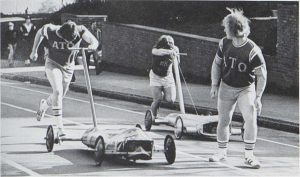
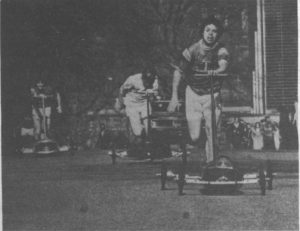

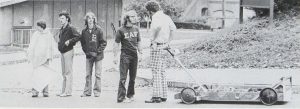
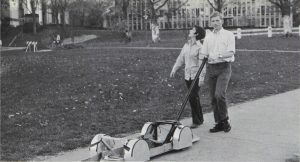
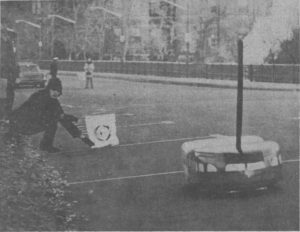

- 1976 Video. Courtesy of an SAE brother known to everyone on the BAA Website as “Elmo Zoneball”, we have the below video from the Saturday of Raceday 1976, featuring the following:
- 0:06-0:09 – A KapSig buggy with no shell
- 0:09-0:20 – A Beta Buggy, either 825 or POS, with no shell
- 0:25-0:55 – Hill 1 of Alumni Exhibition Heat 1, with ZBT in Lane 2 and ATO in Lane 3
- 0:55-1:30 – Hill 1 and 5 of Alumni Exhibition Heat 2, with PhiKap’s Snorpus in Lane 1, SAE’s Arnold (bike) in Lane 2, and Beta’s 825 in Lane 3
- 1:30-1:44 – An unknown heat involving what appears to be ATO and DTD buggies traveling through the Chute
- 1:45-2:06 – SigNu’s Hornet in a reroll through the Chute and up Hill 3
- 2:06-2:17 – Finals Heat 1 with ATO A’s Gander leading, PiKA B’s Pi-thon 2nd and Fringe A’s Flying Buttress third, making the Chute turn.
- 2:17-2:45 – Finals Heat 2 with PiKA A’s T-2 leading, Beta A’s 825 second and PhiKap A’s Streak third, making the Chute turn and going up the back hills.
- 2:46-3:35 – SAE’s brothers on their porch, featuring Intrepid (white buggy) and Arnold (leaning up against the back wall)



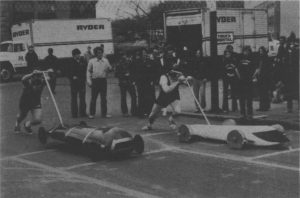

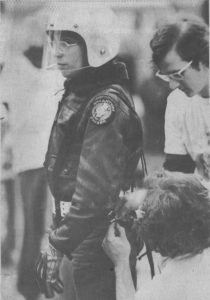

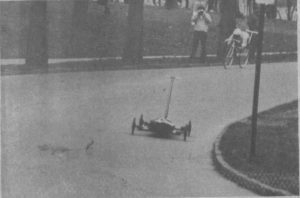
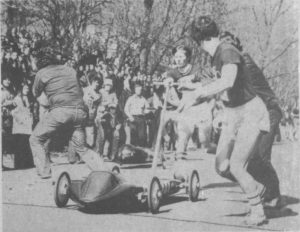
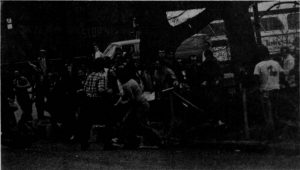
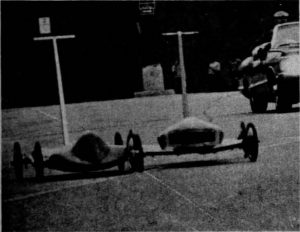
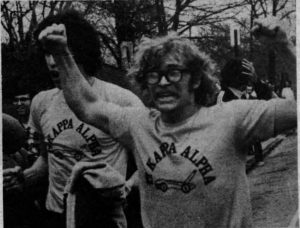
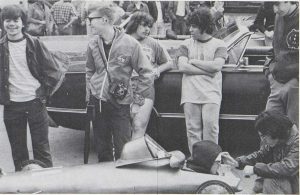
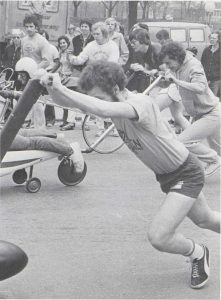
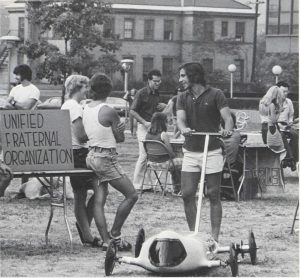
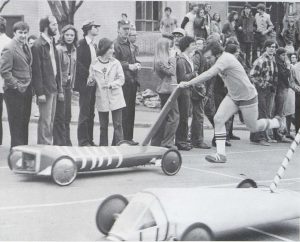

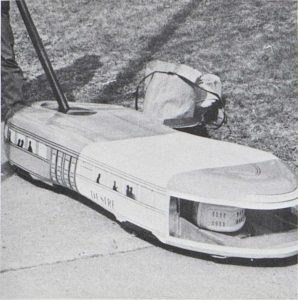

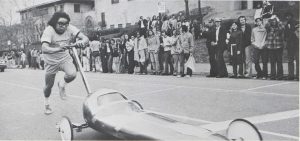

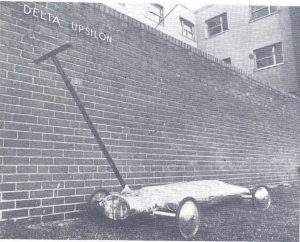
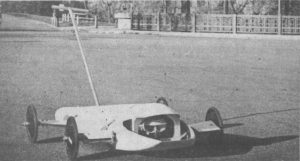

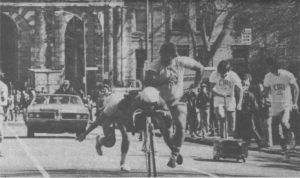
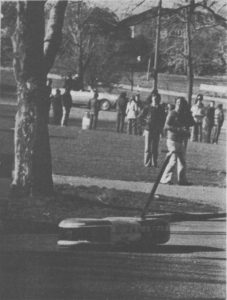
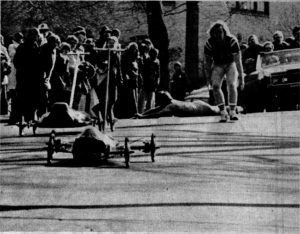
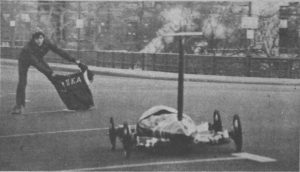
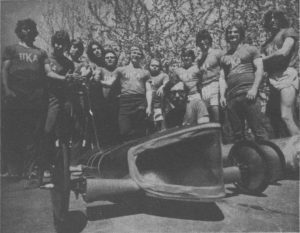

Elmo Zoneball says:
Just to correct this, this is the original “Intrepid” with several modifications, and not a new buggy. The mods included a new body design (original fiberglas body was damaged during late night testing,) and the exotic single pivot 4 wheel steering system was junked in favor of fixed axles bolted to the Aluminum chassis, with a simple knuckle/tie rod steering on the front wheels. It retained the problematic brakes from the original configuration.
Bryan Arsham says:
Thanks! I’ve updated the post accordingly.
Elmo Zoneball says:
As a bonus, here’s a link to my 8mm film of the 1976 Sweepstakes, including slo-motion close-up of three buggies in close succession going through the corner at the bottom of the chute.
https://www.dropbox.com/s/r5egbaqwphxi205/CMU%20Sweepstakes%201976.MP4?dl=0
Bryan Arsham says:
This is amazing! Out of curiosity, can you name the buggies that are included in the video? It looks like the two Chute turns towards the end (at 2:07 and 2:18) are the two Finals heats from 1976, and the white buggy at the end is Intrepid. But I’m curious about the others (I assume the bike that shows up twice is Arnold, but I’m not sure who it’s competing against, and then there are a couple of other buggies that I’m not familiar with).
Elmo Zoneball says:
The rolling chassis with no top at 0:09 is the KS buggy (I think.) Following that is a severely underexposed view of what appears to be BTPi’s “825” (or “POS”) without the top fiberglas bodyshell in place (up to about 0:20.)
The Hill #1 start with a buggy in lane #3 (not sure what buggy, but it appears to be visible later at the 0:50 point, apparently after the heat is finished, and is almost certainly an ATO buggy) and a bike in lane #2 I would guess is from Prelims. Bike is TDPhi, I think, not an SAE bike.
At about 1:00, what appears to be PKT’s “Snorpus” is carried to the starting line. The large wheel nuts are a give-away it’s a Phi Kap buggy of that era. SAE’s “Arnold” — a bike — is visible in lane #2 at the start. BTPi’s “825” is the yellow buggy in lane #3.
At 1:25+, “Arnold” and “825” are visible on Hill #5 approaching the finish line. Not sure what happened to PhiKap’s “Snorpus.”
At ~ 1:40, an ATO buggy leads a DTD buggy through the chute — the Delt buggy is conspicuous with its large diameter pneumatic tires/wheels, something not used by other teams of the era.
Up to the 2:00+ mark, a single buggy is observed from the bottom of the chute, from the Panther Hollow side of Frew Street. It is unmistakably SN’s “Hornet,” regarded as the fastest FR buggy of that era.
First buggy viewed in slo-mo from Conservatory side of the Chute entering the corner is an ATO buggy, at about 2:12. Second buggy is hard ID, but might by Fringe “Flying Buttress.” Third one I can’t make out.
In another heat, at 2:20 – 2:25, we see a PKA buggy leading BTP’s “825” followed by what looks like PhiKap’s “Streak” or “Shadow.” (Since we saw “825” on Hill #1 earlier, this suggests this heat must be from the Finals the following day.)
Final 30 seconds are filmed on SAE’s patio, featuring “Intrepid” in the foreground, and “Arnold” the bike is visible behind it, upside down. The guy leaning against the wall in the green sweater and khaki pants is Bob Thomas, who designed and built”Intrepid” by himself, over a summer.
Hope that helps.
BTW, can someone import this film into the website’s Video Gallery?
Elmo Zoneball says:
Just reviewing the posted info for 1976, I see the film from the chute is of the SN Hornet re-roll, plus the two finals heats:
” SigNu Reroll – After the Exhibitions, SigNu got their chance at a reroll. They ran alone in the heat out of Lane 3, and somewhat surprisingly, their freeroll was slower than the collision-filled Prelim. But their pushers were faster, and therefore they earned an improved final time of 2:26.7.
Finals Heat 1. Finals Heat 1 paired ATO A’s Mongoose, PiKA B’s Pi-thon, and Fringe A’s Flying Buttress, the 2nd, 4th, and 6th fastest times from Prelims, respectively. The race was close but rather uneventful; the buggies went into the freeroll in a single file line with ATO first, Fringe second, and PiKA third, and they stayed that way throughout. ATO A put up a 2:25.0 time, almost identical to their Prelim time. Of note though, Fringe A rolled a 2:28.6 (2 seconds faster than Friday) and PiKA B rolled a 2:30.3 (4 seconds slower than Friday). Since both of those times were slower than SigNu’s reroll, SigNu was placed ahead of them in the final standings, bumping PiKA B down to 7th and costing them a trophy.
Finals Heat 2 – Finals Heat 2 consisted of PiKA A’s T-2, Beta A’s 825, and PhiKap A’s Streak, the 1st, 3rd, and 5th fastest times from Friday, respectively. PiKA led throughout and was aided by a strong freeroll and rollout. Beta challenged PiKA on the backhills with slightly stronger pushers, but PiKA built up enough of a lead in the freeroll that PiKA was able to hang on. PiKA A earned the victory with a 2:23.3 time, which Beta settled for 2nd overall with a 2:24.6 (overtaking ATO in the process). PhiKap’s time of 2:26.5 was good enough for 4th overall. “
Mark Estes says:
Interesting to learn about the record being set in 74. I would not know that from this site’s “records” tab in the history section. What we have there is a list of fastest times, which is not really the same as record times given that many of them occurred after a faster time had been set. To reflect and honor fast buggies of the past, i suggest an additional history tab be added that lists only those times that lowered the mark. Some of them, for only a few moments (i.e. zoo in 81, DU in 88) and others for much longer (spirit in 88).
Frank Robb says:
The picture captioned “1976 A unique buggy travels through the Cut (from 1976 Thistle)” shows the rolling chassis of the CIA Peanut (Dry Roasted) / Streetcar Named Desire / Synergy buggy. The buggy was built in the spring of 1973 but did not race until 1974. The buggy was named “Peanut” after its shape and given a brown paint job with flames. As every gear head knows, flames make a car go faster. When people saw the actual buggy, it was clear the buggy looked like a City of Pittsburgh streetcar/ trolley car that used to run up and down Forbes Ave. So, in 1975, the buggy was repainted to match the colors and graphic layout of a City of Pittsburgh trolley car. Some years later, a new body/shell was made and the buggy was renamed “Synergy”.
Of more significance, the woman in the picture is Beth Kovitz who, I believe, was the first female buggy driver (in 1974).
Ben says:
Also of significance, a dashing young Frank Robb hanging onto the bar in the same photo.